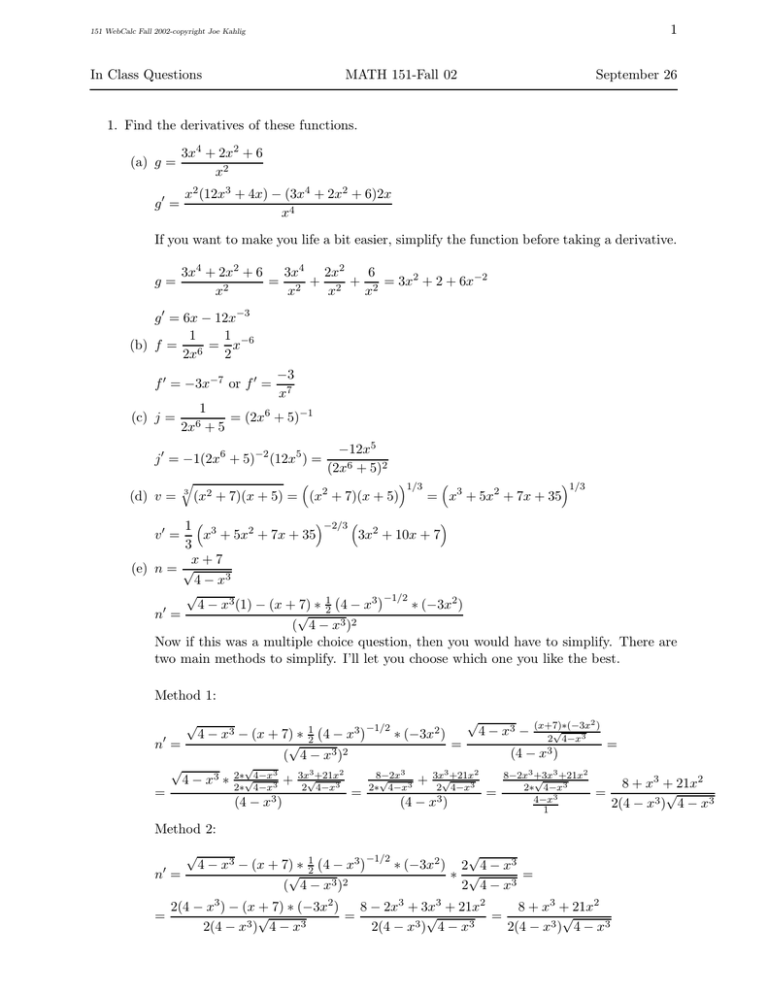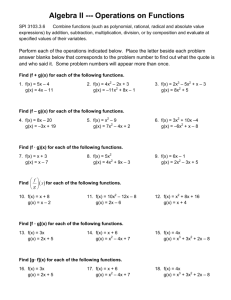1 In Class Questions MATH 151-Fall 02 September 26
advertisement

1 151 WebCalc Fall 2002-copyright Joe Kahlig In Class Questions MATH 151-Fall 02 September 26 1. Find the derivatives of these functions. (a) g = 3x4 + 2x2 + 6 x2 x2 (12x3 + 4x) − (3x4 + 2x2 + 6)2x x4 g0 = If you want to make you life a bit easier, simplify the function before taking a derivative. g= 3x4 + 2x2 + 6 3x4 2x2 6 = + 2 + 2 = 3x2 + 2 + 6x−2 x2 x2 x x g0 = 6x − 12x−3 1 1 (b) f = 6 = x−6 2x 2 f 0 = −3x−7 or f 0 = (c) j = −3 x7 1 = (2x6 + 5)−1 2x6 + 5 j 0 = −1(2x6 + 5)−2 (12x5 ) = q (d) v = 3 −12x5 (2x6 + 5)2 1/3 (x2 + 7)(x + 5) = (x2 + 7)(x + 5) 1/3 = x3 + 5x2 + 7x + 35 −2/3 1 3 x + 5x2 + 7x + 35 3x2 + 10x + 7 3 x+7 (e) n = √ 4 − x3 √ −1/2 4 − x3 (1) − (x + 7) ∗ 12 4 − x3 ∗ (−3x2 ) 0 √ n = ( 4 − x3 )2 Now if this was a multiple choice question, then you would have to simplify. There are two main methods to simplify. I’ll let you choose which one you like the best. v0 = Method 1: √ n0 = √ = 4 − x3 − (x + 7) ∗ 12 4 − x3 √ ( 4 − x3 )2 4 − x3 ∗ √ 3 2 2∗√4−x3 √+21x + 3x 2∗ 4−x3 2 4−x3 (4 − x3 ) −1/2 ∗ (−3x2 ) 3 = 8−2x √ 2∗ 4−x3 + (4 − √ = 2) (x+7)∗(−3x √ 2 4−x3 − x3 ) 4 − x3 − 3 +21x2 3x√ 2 4−x3 x3 ) (4 = 3 +21x2 8−2x3 +3x √ 2∗ 4−x3 4−x3 1 = = Method 2: √ 0 n = = 4 − x3 − (x + 7) ∗ 12 4 − x3 √ ( 4 − x3 )2 −1/2 ∗ (−3x2 ) √ 2 4 − x3 ∗ √ = 2 4 − x3 2(4 − x3 ) − (x + 7) ∗ (−3x2 ) 8 − 2x3 + 3x3 + 21x2 8 + x3 + 21x2 √ √ √ = = 2(4 − x3 ) 4 − x3 2(4 − x3 ) 4 − x3 2(4 − x3 ) 4 − x3 8 + x3 + 21x2 √ 2(4 − x3 ) 4 − x3 2 151 WebCalc Fall 2002-copyright Joe Kahlig 2. Find the equation of the tangent line at x = 3 for f (x) = (x3 − 6)5 + 28 f 0 (x) = 5(x3 − 6)4 ∗ 3x2 . To find the equation of the tangent line we need a point and a slope. f (3) = 4084357 and f 0 (3) = 26254935 Answer: y − 4084357 = 26254935(x − 3) 3. Use the table of information to compute the following. If it is not possible explain why. x f (x) f 0 (x) 2 5 6 3 4 7 4 3 8 5 2 9 x g(x) g0 (x) 2 1 −5 3 2 −6 4 5 −7 5 8 −9 J(x) = (2f + g)(x) = 2f (x) + g(x) H(x) = f f (x) (x) = f −g f (x) − g(x) K(x) = (x2 + 7)f (x) (a) J 0 (x) = 2f 0 (x) + g0 (x) so J 0 (4) = 2f 0 (4) + g0 (4) = 2 ∗ 8 + −7 = 16 − 7 = 9 (b) H 0 (x) = H 0 (5) = (f (x) − g(x)) ∗ f 0 (x) − f (x) ∗ (f 0 (x) − g0 (x)) (g(x))2 (f (5) − g(5)) ∗ f 0 (5) − f (5) ∗ (f 0 (5) − g0 (5)) (2 − 8) ∗ 9 − 2 ∗ (9 − −9) −90 = = 2 2 (g(5)) (8) 64 (c) K 0 (3) df 4. Find if the function is defined as f = da x9 − 6x3 + 7 √ (x3 − 6)10 x8 − 10 !10 df The derivative of this function is zero. tells us to take the derivative with respect to the da variable a.







